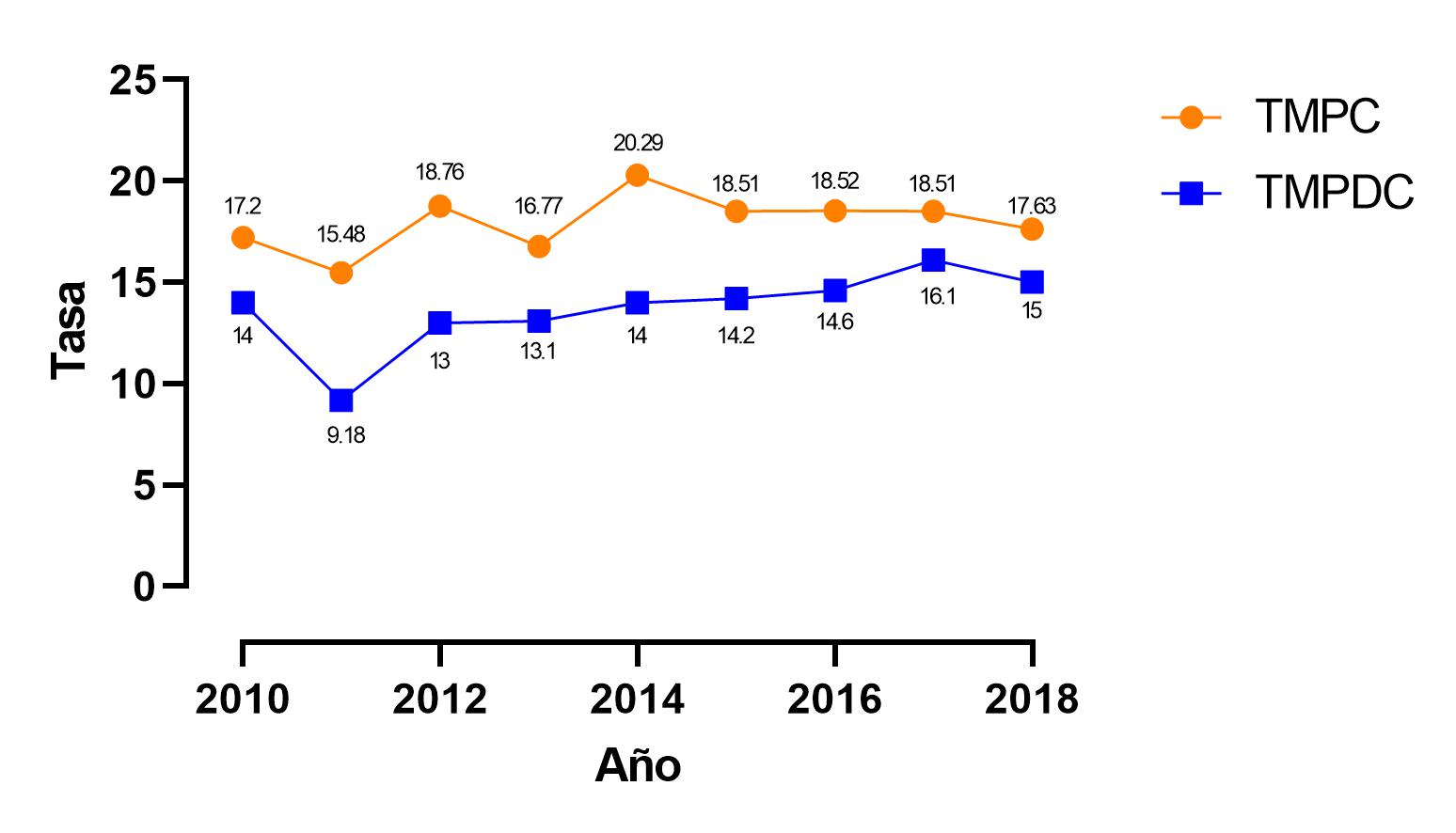Epidemiological profile of perinatal mortality in the department of Cauca, Colombia, 2010-2018.
Main Article Content
Abstract
Introduction: perinatal mortality is a serious public health problem worldwide. It is estimated that 98 % occur in developing countries. In the Department of Cauca, Colombia, the rates remain constant and even exceed the national ones. Objective: to determine the epidemiological profile of perinatal mortality in the Department of Cauca between 2010 and 2018. Methods: Retrospective cohort in which all cases of perinatal mortality registered in the database of the Epidemiological Surveillance System were included. Nacional, from the Department of Cauca, from 2010 to 2018. The analysis was carried out in SPSS version 19.0. Results: 2.527 records of perinatal deaths were included during the study period; 42.9 % of the mothers with cases of perinatal deaths were between 20 and 29 years old; 80.61 % belonged to the subsidized regime; 26.2 % of the mothers were indigenous; 42.50 % had a secondary educational level; 18% of the mothers had some method of family planning; 57 % had less than four prenatal check-ups, and 64.51 % had late prenatal check-ups (after the first trimester of pregnancy). 40.04 % of perinatal deaths were secondary to asphyxia; 69.5 % had low birth weight (<2500 grams), and 69.9 % had gestational ages below 37 weeks. 55.5 % of the cases occurred in the antepartum. Conclusions: Perinatal mortality rates in the Department of Cauca have remained constant. It is more frequent in mothers affiliated with the subsidized regime, belonging to an ethnic group, with a low educational level, low fertility regulation, a history of fetal death, and limited prenatal check-ups.
Downloads
Article Details

This work is licensed under a Creative Commons Attribution-NonCommercial-NoDerivatives 4.0 International License.
Creative Commons
License Attribution-NonCommercial-ShareAlike 4.0 International (CC BY-NC-SA 4.0)
You are free to:
Share - copy and redistribute the material in any medium or format.
Adapt - remix, transform, and build upon the material The licensor cannot revoke these freedoms as long as you follow the license terms.
• Attribution — You must give appropriate credit, provide a link to the license, and indicate if changes were made. You may do so in any reasonable manner, but not in any way that suggests the licensor endorses you or your use.
• NonCommercial — You may not use the material for commercial purposes.
• ShareAlike — If you remix, transform, or build upon the material, you must distribute your contributions under the same license as the original.
• No additional restrictions — You may not apply legal terms or technological measures that legally restrict others from doing anything the license permits.
References
Ticona M, Huanco D. Mortalidad perinatal hospitalaria en el Perú: Factores de riesgo. Rev Chil Obstet Ginecol. 2005;70(5):313-317. DOI: https://doi.org/10.4067/S0717-75262005000500006
Instituto Nacional de salud. Boletín epidemiológico semanal. Mortalidad Perinatal y Neonatal. [Internet]. 2018 [citado 2021 junio 14]. Disponible en: https://www.ins.gov.co/buscador-eventos/BoletinEpidemiologico/2018%20Bolet%C3%ADn%20epidemiol%C3%B3gico%20semana%2032.pdf.
Profamilia. Encuesta Nacional de Demografía y Salud Tomo 1. 2018. [Internet] 2018 [citado 2021 junio 18].Disponible en: https://profamilia.org.co/wp-content/uploads/2018/12/ENDS-TOMO-I.pdf.
Gómez C. Mortalidad perinatal en el Hospital general León Guanajuato México. [Internet] 2014 [citado 2021 junio 6]. Disponible en: https://www.gestiopolis.com/mortalidad-perinatal-en-el-hospital-general-leon-guanajuato-mexico/.
Jaramillo M. Mortalidad materna y perinatal en una EPS indígena en el departamento del Cauca entre los años 2007 a 2011. [Internet] 2011 [citado 2021 junio 6]. Disponible en: http://bibliotecadigital.univalle.edu.co/handle/10893/9892.
Instituto Nacional de Salud. Mortalidad perinatal y neonatal tardía. [Internet] 2017 [citado 2021 junio 6]. Disponible en: https://www.ins.gov.co/buscador-eventos/Lineamientos/Pro_Mortalidad%20perinatal%20y%20neonatal%20tardia.pdf.
Ministerio de Salud y Protección Social. Guías de Práctica Clínica para la prevención, detección temprana y tratamiento de las complicaciones del embarazo, parto o puerperio. [Internet] 2013 [citado 2021 junio 6]. Disponible en: https://www.minsalud.gov.co/sites/rid/Lists/BibliotecaDigital/RIDE/INEC/IETS/G.Corta.Embarazo.y.parto.Prof.Salud.2013%20(1).pdf.
Dámaso-Mata B, Carbajal-Álvarez C, Loza-Munarriz C, Raraz-Vidal J. Factores relacionados a la mortalidad perinatal en un hospital público de Huánuco. Acta Médica Perú. 2014;31(1):15-22. DOI: https://doi.org/10.35663/amp.2014.313.193
Ministerio de Salud Pública y Asistencia Social de Guatemala. Protocolo de Vigilancia Epidemiológica de mortalidad perinatal y neonatal tardía. 2017. [Internet] 2018 [citado 2021 junio 6].Disponible en: https://osarguatemala.org/wp-content/uploads/2018/07/Protocolo-Mortalidad-Perinatal.pdf.
Ministerio de salud pública. Anuario estadístico de salud. 2020. [Internet] 2020 [citado 2021 junio 6].Disponible en: https://files.sld.cu/bvscuba/files/2020/05/Anuario-Electr%C3%B3nico-Espa%C3%B1ol-2019-ed-2020.pdf.
Gómez S, Fajardo C, Sarmiento J. Líneas de pobreza en el Cauca. Revista de economía del
Caribe. Nro. 17 [Internet] 2016 [citado 2022 diciembre 10]. Disponible en: hhttps://rcientificas.uninorte.edu.co/index.php/economia/article/view/7777/pdf_273
Instituto Nacional de Salud. Boletín epidemiológico semanal. http://bvs.minsa.gob.pe/local/DGSP/481_DGSP240.pdf. [Internet] 2009 [citado 2021 junio 6]. Disponible en:https://www.ins.gov.co/buscador-eventos/BoletinEpidemiologico/2020_Boletin_epidemiologico_semana_9.pdf.
Ministerio de Salud de Panamá. Plan estratégico para la reducción de la morbilidad y mortalidad materna y perinatal 2006. [Internet] 2018 [citado 2021 junio 6].Disponible en: https://www.paho.org/pan/index.php?option=com_docman&view=download&alias=29-plan-estrategico-para-la-reduccion-de-la-morbilidad-y-mortalidad-materna-y-perinatal&category_slug=publications&Itemid=224.
Martins F, Rezende M, Almeida M, Lana F. Perinatal mortality and socio-spatial inequalities. Revista Latino-Americana de Enfermagem, 2013; 21(5): 1062-1070. DOI: https://doi.org/10.1590/S0104-11692013000500008
Ticona R, Huanco D. Factores de riesgo de la mortalidad perinatal en hospitales del Ministerio de Salud del Perú. Revista Cubana de Obstetricia y Ginecología. 2011; 37(3):431-443.
Valdez, G, Meza R, Ñuñez J, Ocampo A. Etiología de la mortalidad perinatal. Perinatol Reprod Hum 2009; 23: 1-4.
Lozano O, Correa L, Luna C. Controles prenatales y su asociación con la morbimortalidad del recién nacido en el Hospital Sergio Bernales. Rev. Fac. Med. Hum. 2018;18(1):38-44.
Ministerio de salud y protección social. Guías de Práctica Clínica (GPC) para la prevención, detección temprana y tratamiento de las alteraciones del embarazo, parto y el puerperio 2013. [Internet] 2013 [citado 2021 julio 8]. Disponible en: https://www.minsalud.gov.co/sites/rid/Lists/BibliotecaDigital/RIDE/INEC/IETS/Gu%C3%ADa.completa.Embarazo.Parto.2013.pdf.
Rivera M, Lara N, Baró T. Asfixia al nacer: factores de riesgo materno y su percepción en la mortalidad perinatal. Revista información científica. 2018. [Internet]. [citado 2022 diciembre 10] Disponible en: http://scielo.sld.cu/pdf/ric/v97n5/1028-9933-ric-97-05-1020.pdf
Organización mundial de la salud. Manteniendo promesas y evaluando resultados. 2011. [Internet] 2011 [citado 2021 julio 8]. Disponible en: https://apps.who.int/iris/bitstream/handle/10665/44674/9789243564326_spa.pdf;jsessionid=E72474E4C8BD0A87BBC8119C949D4D7D?sequence=1.





